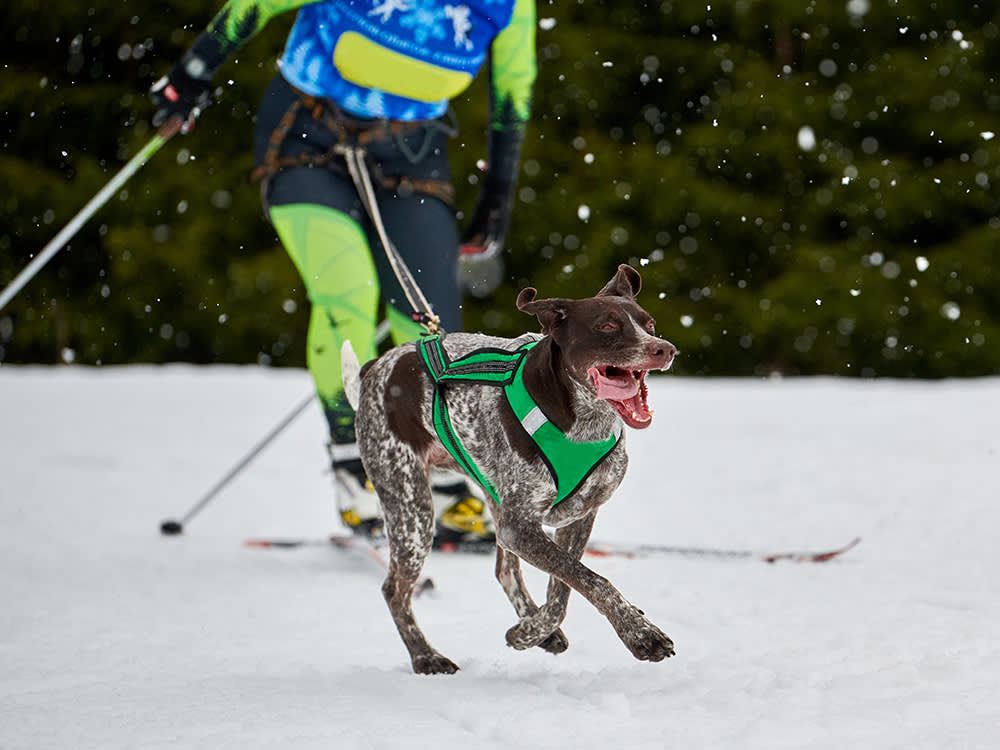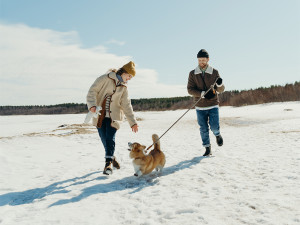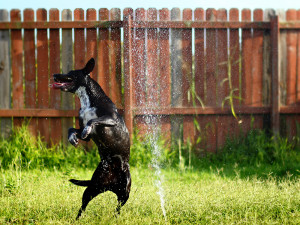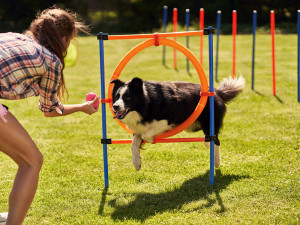How to Ski With Your Dog
Dogs don’t have to be pro athletes to enjoy some quality time in the snow.
In this Article:
Guide to Dog Skijoring Best Breeds for Skijoring Equipment for Dog Skijoring How to Teach Your Dog Skijoring Safety Precautions for Dog Skijoring
Powder, hard pack, drift, blizzard — whatever you call it, snow’s a fact of winter life in many parts of the country. It covers our favorite paths and can turn casual outings into endurance sports, instead of fun hikes. What’s a pup and their person to do when it’s colder than a three-dog night?
Well, as it turns out, plenty. If you can walk, you can snowshoe or cross-country ski, and if you’re even moderately skilled on those skis, you can skijor, too. The best part is your dog can join you, and they don’t have to be a Husky to enjoy the experience. Aerobic, calorie-burning, and low-impact, all three activities are pretty simple to learn.
Trick question: All dogs are perfect! But find out which type is the best fit for you.
What is dog skijoring?
Skijoring is, simply, cross-country skiing while being pulled by something, in this case a dog. Pronounced ski-jaw-ring, the term “skijoring” comes from a Norwegian word that literally means “ski driving.” In dog skijoring, a dog or a team of dogs pulls a skier through the snow. Similar to dog mushing (a sled pulled by dogs), skiing with a dogopens in new tab or pair of dogs was invented in Scandinavia for a more convenient mode of travel and has since become a popular recreational and competitive activity.
How much do you spend on your pet per year?
Dog skiing is generally done with one or two dogs and can be a fun way to keep your pup physically active, reducing boredom, which can result in destructive behavior and stress. The colder weather is also a great time to exercise your dog without worrying about the risk of them overheating, which can be a major concern in summertime activities.
Best breeds for skijoring
The best dog breeds for skijoring are usually those who have a natural instinct to pull. Think dogs like the Siberian Husky, Samoyed, or Alaskan Malamute, who are all still commonly found on sled teams. But if you don’t have a cold-weather-obsessed dog, don’t count your pup out. Many competitive athletes started skijoring with other large breeds, like Border Collies, Labradors, German Shepherds, and Golden Retrievers. In short, if your dog is medium or large, athletic, and enthusiastic about pulling you on skis, it doesn’t hurt to consider skijoring.
Even smaller dogs can sometimes participate in skijoring, especially if they love to run. Just keep in mind that they won’t pull you as fast as a larger dog, and you may need to consider their weight and size to determine if they can safely pull a human.
Equipment for dog skijoring
As with any activity, whether you’re sticking around home or traveling to a dog-friendly skiing destination, you need the right equipment to safely enjoy skiing with dogs. For skijoring, dog equipment includes a harness, as well as apparel. A standard dog harness won’t do; instead, your pup needs a special skijoring dog harness designed for pulling that allows them to both move and breathe freely. And you will need a skijoring belt that allows you to connect to your dog with an elastic lead.
Unless they’re a Malamute or another double-coated breed, your dog will also need a jacket to keep them warm and something to protect their feet from the cold and frostbite — booties or a paw balm made for dogs. And make sure to bundle up in warm clothing yourself: we’re talking wool socks, a jacket or coat, hat, scarf, and gloves.
If you’re just starting out with skijoring, rental equipment is the way to go. Renting allows you to try a variety of brands and types to find out what suits you best before investing in your own dog skijoring kit.
How to teach your dog skijoring
Before you try out skijoring, practice cross-country skiing on your own to make sure you can maneuver and stop properly before you add a dog to the mix. Choose which type of skiing you plan to do:
Classic, which is easiest for beginners and more similar to walking
Skating, which is the technique competitive skiers use
Taking time to practice your own skiing skills can ensure that you transition more easily to skijoring with your dog — and avoid any accidents with other skiers or their pups. Once you have a good foundation for cross-country skiing, you can begin to train your dog with the following steps:
Introduce your dog to your skijoring equipment so they aren’t scared. This make take several days or longer.
Work on basic obedience and teaching your dog to stand still while you gear up and put on skis. Your dog should also hold still while you put on their harness.
Teach your dog how to pull. When it comes to walking, you want your dog not to pull, but for skijoring, you want to encourage this behavior — and most dogs are eager to oblige!
Work on skijoring commands, such as turning left or right and slowing down.
Teach your dog to obey your direction while skijoring. You may want to invest in ski-trainingopens in new tab to learn how to safely guide your dog around obstacles and other skiers.
Try skiing while your dog runs with you, unattached, and then try a brief run with your dog safely attached to you.
Safety precautions for dog skijoring
Before venturing into the cold wilderness, check with your vet to be sure your dog’s up for skijoring. It’s recommended that dogs should be at least 30 pounds; smaller dogs may put undue pressure on their bodies. While you’re at it, check your own health as well. Skijoring can be demanding on the knees and lower back.
If you’re new to skiing, look for a Nordic center where you can take a few cross-country lessons and consider investing in skijoring dog training. Once you feel prepared, follow these tips for how to skijor with your dog and ensure their safety in the snow:
Understand your limitations. Stick to trails that are the appropriate difficulty for both your and your dog’s skill levels.
Always warm up both you and your dog before skijoring and cool down after to help both of you feel better and avoid injury.
Be prepared for an emergency when heading into the backcountry. Always bring first-aid supplies (and know how to use them) and have a plan for how to carry your dog to safety.
Make sure to use the right equipment for both you and your dog.
Don’t force your dog to go skijoring if they’re not enthusiastic about running and pulling. Choose a cozy indoor activity instead.
Ensure your pup has all the right apparel to keep warm in cold weather.
FAQs (People also ask):
Can my dog participate in dog skijoring?
Dogs who are healthy and enjoy running and pulling can participate in skijoring, as long as they are over 30 pounds. Consult with your vet before engaging in any high-intensity physical activities with your dog.
What is the best harness for dog skijoring?
The harnesses used for dog skijoring are similar to those used for sledding. Take time to research which harness is best for your dog’s size and the trails you plan to use.
How much weight can a dog pull when skijoring?
In general, dogs can pull as much as three to four times their own body weight, but just like human weight training, your dog should start with lighter loads and work their way up to build up their strengthopens in new tab and stamina.







